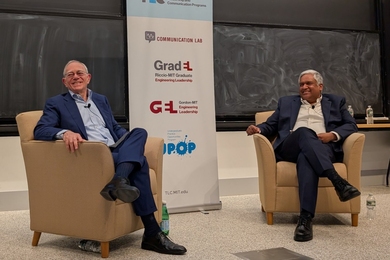Today, data is everywhere. But how can people learn to make sense of it? One intensive economics course at MIT is built around doing just that, by getting undergraduate students to produce research papers while working closely with faculty.
So while floods of data now exist on scores of subjects, the goal is to get students to think critically about the methods of economics, find areas of study that interest them, and “turn topics into research questions,” as Heidi Williams, an assistant professor of economics, puts it.
Williams taught the class, 14.33 (Research and Communication in Economics), last fall. It is actually a class in econometrics, the study of the methods of economics, and builds upon an earlier introductory econometrics course, 14.32. But while the introductory course surveys statistical tools more broadly, the students in 14.33 are aiming to create applied research themselves.
In the class, students began by identifying research topics over the first few weeks of the semester, as Williams lectured on the nuances of academic research. Each student then presented a proposed research topic to the 19 others in the class. Over the next several weeks, all of the students met repeatedly with the instructors — Williams and PhD student Christopher Palmer — to meet a series of “benchmarks” in the development of their research projects.
“The question comes before the specific method,” Palmer explains.
The result is a kind of hybrid course — part lecture, part student presentations and part guided research — ultimately aimed at promoting critical thinking.
“I get energized talking with the students, and I really enjoy the interaction,” says Williams, who adds that she was “very pleased” with the quality of final papers produced.
Spot the Spotify effect
Online consumer piracy has long been a thorny issue in the music business. But the low-cost music site Spotify has become a popular alternative, seemingly filling a niche for consumers who cannot spend much on music, but don’t wish to listen to pirated music.
But is there some way to tell if Spotify lowers piracy rates? MIT senior Jenny Shen thinks she found one. Spotify now exists in 15 countries. Looking at the dates of introduction for Spotify in various countries, Shen used Google Trends data to see if an effect could be identified. She looked for searches with the terms “Spotify” and “Grooveshark” (a competitor) to see how much those sites were being accessed, and looked for a decline in searches with key terms associated with piracy.
The set of “novice downloaders,” as Shen calls them, would likely use terms such as “Adele Rolling in the deep mp3,” or “Adele Rolling in the deep mp3 download.” Google Trends data includes all searches containing a term — not just the exact term — and so yields a reasonable proxy for music-piracy attempts.
“I wanted to see if Spotify affected people’s music consumption, and then it turned into a piracy study,” Shen says. The result? Shen found that the introduction of Spotify decreased piracy by 13 percent, on average. The level of statistical significance of that result, however, depends on whether the data is regarded as coming from a series of country-level experiments or whether it represents one larger global trend.
“Professor Williams and Christopher Palmer were very supportive and provided a lot of great feedback,” says Shen, who will present the paper during a conference at Mercer University in April, and thinks the study could provide useful information for both consumers and the music industry.
A suboptimal job search
Senior C.J. Enloe developed her 14.33 paper out of a real-world experience: As part of MIT’s Undergraduate Research Opportunities Program (UROP), she visited career centers where unemployed workers can gain support through workshops and other structured programs. Many such centers have requirements about the circumstances in which job offers must be accepted, however. After a while, Enloe began to wonder if these policies were forcing workers into accepting suboptimal jobs quickly, rather than waiting a little longer for better opportunities.
For her 14.33 paper, Enloe developed a scale to measure the restrictiveness of career centers’ policies, including their demands that job offers must be taken. Looking at data from the Current Population Survey (among other sources) covering all 50 states, she found that a one-point increase in her scale of the restrictiveness of career-center policies led to a 3.48 percent decrease in earnings.
By pushing people into new jobs, the centers are, to be sure, lowering the average duration of unemployment, Enloe notes. However, “That might change their searches, and not in a positive way,” she adds.
In developing this finding, Enloe accounted for state-by-state and temporal variations in earnings. And she had to overcome a methodological issue involving “compositional bias” — namely, whether the people in her study were simply less likely to reacquire jobs. To test this concern, Enloe did regression analysis, finding no correlation between strict career-center policies and the likelihood of re-employment in a given year.
What effect is Google Transit having?
Senior Andrew Stuntz had a transportation research internship after his sophomore year. As a result, when he started thinking about paper topics for 14.33, he began wondering if online tools could help boost public-transit use.
“Transit agencies are very constrained in the ways they can affect ridership,” he says. So Stuntz decided to see if Google Transit, an online public-transportation search tool the technology firm first rolled out in 2005, was having an impact.
Working with the cooperation of Google, which provided data on the time periods when it integrated the tool into its mapping system, Stuntz looked at 191 transit systems across the United States to see if this helped increase ridership; he correlated the Google data with ridership numbers from the Federal Transit Administration. To make the study stronger, Stuntz had to account for several complicating factors, such as seasonal cycles in ridership, and longer-term trends in public-transit use.
In his paper, Stuntz was “unable to identify any effect of Google Transit on public transportation ridership,” but was also unable to rule out that Google Transit was having an effect. For one thing, Stuntz was not able to account for every complicating factor, such as fare increases and regional economic conditions. It is possible, he says, that Google Transit provided a boost to ridership, even as that boost was offset by higher unemployment in some cities, for instance.
If Google Transit were having even a modest impact, Stuntz suggests, it would be worth discerning. “Even a 1 percent increase in ridership would be significant because the cost [to transportation agencies] is so low,” Stuntz adds.
From Williams’ point of view, posing a question correctly, and acknowledging that the results do not yield a firm answer, is itself part of the learning process — and one reason she plans to continue teaching 14.33.
“I find it to be an incredibly rewarding class to teach,” Williams says.
So while floods of data now exist on scores of subjects, the goal is to get students to think critically about the methods of economics, find areas of study that interest them, and “turn topics into research questions,” as Heidi Williams, an assistant professor of economics, puts it.
Williams taught the class, 14.33 (Research and Communication in Economics), last fall. It is actually a class in econometrics, the study of the methods of economics, and builds upon an earlier introductory econometrics course, 14.32. But while the introductory course surveys statistical tools more broadly, the students in 14.33 are aiming to create applied research themselves.
In the class, students began by identifying research topics over the first few weeks of the semester, as Williams lectured on the nuances of academic research. Each student then presented a proposed research topic to the 19 others in the class. Over the next several weeks, all of the students met repeatedly with the instructors — Williams and PhD student Christopher Palmer — to meet a series of “benchmarks” in the development of their research projects.
“The question comes before the specific method,” Palmer explains.
The result is a kind of hybrid course — part lecture, part student presentations and part guided research — ultimately aimed at promoting critical thinking.
“I get energized talking with the students, and I really enjoy the interaction,” says Williams, who adds that she was “very pleased” with the quality of final papers produced.
Spot the Spotify effect
Online consumer piracy has long been a thorny issue in the music business. But the low-cost music site Spotify has become a popular alternative, seemingly filling a niche for consumers who cannot spend much on music, but don’t wish to listen to pirated music.
But is there some way to tell if Spotify lowers piracy rates? MIT senior Jenny Shen thinks she found one. Spotify now exists in 15 countries. Looking at the dates of introduction for Spotify in various countries, Shen used Google Trends data to see if an effect could be identified. She looked for searches with the terms “Spotify” and “Grooveshark” (a competitor) to see how much those sites were being accessed, and looked for a decline in searches with key terms associated with piracy.
The set of “novice downloaders,” as Shen calls them, would likely use terms such as “Adele Rolling in the deep mp3,” or “Adele Rolling in the deep mp3 download.” Google Trends data includes all searches containing a term — not just the exact term — and so yields a reasonable proxy for music-piracy attempts.
“I wanted to see if Spotify affected people’s music consumption, and then it turned into a piracy study,” Shen says. The result? Shen found that the introduction of Spotify decreased piracy by 13 percent, on average. The level of statistical significance of that result, however, depends on whether the data is regarded as coming from a series of country-level experiments or whether it represents one larger global trend.
“Professor Williams and Christopher Palmer were very supportive and provided a lot of great feedback,” says Shen, who will present the paper during a conference at Mercer University in April, and thinks the study could provide useful information for both consumers and the music industry.
A suboptimal job search
Senior C.J. Enloe developed her 14.33 paper out of a real-world experience: As part of MIT’s Undergraduate Research Opportunities Program (UROP), she visited career centers where unemployed workers can gain support through workshops and other structured programs. Many such centers have requirements about the circumstances in which job offers must be accepted, however. After a while, Enloe began to wonder if these policies were forcing workers into accepting suboptimal jobs quickly, rather than waiting a little longer for better opportunities.
For her 14.33 paper, Enloe developed a scale to measure the restrictiveness of career centers’ policies, including their demands that job offers must be taken. Looking at data from the Current Population Survey (among other sources) covering all 50 states, she found that a one-point increase in her scale of the restrictiveness of career-center policies led to a 3.48 percent decrease in earnings.
By pushing people into new jobs, the centers are, to be sure, lowering the average duration of unemployment, Enloe notes. However, “That might change their searches, and not in a positive way,” she adds.
In developing this finding, Enloe accounted for state-by-state and temporal variations in earnings. And she had to overcome a methodological issue involving “compositional bias” — namely, whether the people in her study were simply less likely to reacquire jobs. To test this concern, Enloe did regression analysis, finding no correlation between strict career-center policies and the likelihood of re-employment in a given year.
What effect is Google Transit having?
Senior Andrew Stuntz had a transportation research internship after his sophomore year. As a result, when he started thinking about paper topics for 14.33, he began wondering if online tools could help boost public-transit use.
“Transit agencies are very constrained in the ways they can affect ridership,” he says. So Stuntz decided to see if Google Transit, an online public-transportation search tool the technology firm first rolled out in 2005, was having an impact.
Working with the cooperation of Google, which provided data on the time periods when it integrated the tool into its mapping system, Stuntz looked at 191 transit systems across the United States to see if this helped increase ridership; he correlated the Google data with ridership numbers from the Federal Transit Administration. To make the study stronger, Stuntz had to account for several complicating factors, such as seasonal cycles in ridership, and longer-term trends in public-transit use.
In his paper, Stuntz was “unable to identify any effect of Google Transit on public transportation ridership,” but was also unable to rule out that Google Transit was having an effect. For one thing, Stuntz was not able to account for every complicating factor, such as fare increases and regional economic conditions. It is possible, he says, that Google Transit provided a boost to ridership, even as that boost was offset by higher unemployment in some cities, for instance.
If Google Transit were having even a modest impact, Stuntz suggests, it would be worth discerning. “Even a 1 percent increase in ridership would be significant because the cost [to transportation agencies] is so low,” Stuntz adds.
From Williams’ point of view, posing a question correctly, and acknowledging that the results do not yield a firm answer, is itself part of the learning process — and one reason she plans to continue teaching 14.33.
“I find it to be an incredibly rewarding class to teach,” Williams says.






